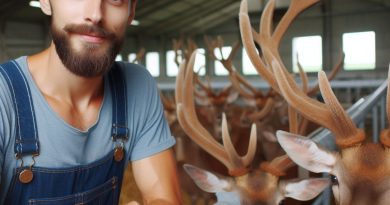Sustainable Grazing: Balancing Land & Livestock
Last Updated on November 26, 2023
Introduction
Throughout the years, the concept of sustainable grazing has gained significant importance in the agricultural industry.
Sustainable grazing can be defined as a method of managing livestock in order to maintain the long-term health of the land and its resources.
The balance between land and livestock is essential for sustainable grazing practices.
When done correctly, it can lead to numerous benefits, both for the environment and the farmers.
It helps in preserving the natural habitat, improving soil health, and reducing the risk of soil erosion.
One of the key aspects of balancing land and livestock is rotational grazing.
This practice involves dividing the pasture into smaller paddocks and moving livestock from one area to another periodically.
By allowing the land to rest and recover, rotational grazing promotes healthy grass growth and prevents overgrazing.
Another important factor is the proper stocking rate, which refers to the number of livestock grazing on a given area of land.
Maintaining an appropriate stocking rate is crucial to prevent overgrazing, which can lead to soil degradation and decreased forage production.
Implementing sustainable grazing techniques can significantly improve the overall health and productivity of the land.
It helps in preserving biodiversity, enhancing water quality, and reducing greenhouse gas emissions.
Additionally, sustainable grazing practices contribute to the farmers’ economic stability by ensuring long-term productivity and reducing dependence on external resources.
In short, sustainable grazing is an essential approach for managing livestock in a way that maintains the health of the land and its resources.
By balancing the needs of both land and livestock, farmers can achieve long-term sustainability while also benefiting the environment and their own livelihoods.
Benefits of Sustainable Grazing
Sustainable grazing benefits land and livestock. It improves soil health, enhancing organic matter content.
Livestock rotation aids land recovery, prevents erosion, and maintains nutrients. Cattle hooves aid plant material decomposition.
Increased biodiversity is another benefit. Diverse plant growth provides wildlife habitats.
Grazing maintains plant balance, curbing invasive species. Proper intensity preserves native vegetation.
Grazing management conserves water. Improved soil retains water, minimizing drought impact.
Sustainable grazing protects riparian areas, aiding water conservation.
It reduces greenhouse gas emissions. Well-managed lands act as carbon sinks.
Rotational grazing cuts synthetic fertilizer needs, lowering nitrous oxide emissions.
Farmers mitigate climate change by adopting sustainable grazing methods.
Sustainable grazing yields diverse benefits: soil health, biodiversity, water conservation, and reduced emissions.
Adopting these practices secures long-term land and livestock sustainability while safeguarding the environment.
Read: Smart Fencing Solutions for Livestock Safety
Strategies for Balancing Land and Livestock
Rotational grazing maximizes forage use and pasture health. It divides land into smaller paddocks for livestock rotation.
This method ensures recovery time for each section, preventing overgrazing and enhancing forage growth.
Its benefits are numerous:
- Improved forage use: Moving livestock allows regrowth, boosting pasture health and capacity.
- Weed and brush control: Reducing erosion, enhancing nutrient cycling.
- Successful systems: MiG (Management-intensive Grazing) optimizes pasture use and recovery.
- Benefits reported: Higher livestock performance, soil health, increased profits.
Balancing land and livestock involves optimal stocking rates. Consider forage, animal needs, and environmental factors.
Avoid understocking for better economic returns. Overstocking damages land, reduces performance.
Regular monitoring adjusts rates for productivity and sustainability.
Proper grazing management matters:
- Using native species: Boosts biodiversity, improves livestock nutrition.
- Rest periods: Allow pastures to rejuvenate, ensuring long-term productivity.
Infrastructure matters too:
- Fencing, water access: Controls grazing, protects sensitive areas, promotes balance.
Strategies include rotational grazing, stocking rates, effective management. They enhance Regenerative grazing.
Implementing these strategies ensures success and environmental stewardship. Farmers should consider adopting these approaches for long-term benefits.
Read: Livestock Behavior: Understanding Your Animals
Collaboration and Support for Sustainable Grazing
Government initiatives and programs
- Governments play a vital role in promoting and supporting these practices on agricultural lands.
- They can implement policies, regulations, and initiatives that encourage farmers and ranchers to adopt these methods.
- Governments can also provide financial assistance and incentives for implementing these practices.
- Programs such as cost-sharing arrangements, technical assistance, and training can be offered to support farmers in their transition to Regenerative grazing.
- Governments can collaborate with researchers and experts to develop guidelines and best practices for Regenerative grazing.
Partnerships with conservation organizations
- Collaboration with conservation organizations can help facilitate the adoption of the practices.
- Conservation organizations can provide technical expertise, resources, and support to farmers and ranchers.
- They can offer training programs and workshops on these methods and their environmental benefits.
- Conservation organizations can also assist in monitoring and evaluating the impact of these practices on land and wildlife.
- Partnerships between farmers, ranchers, and conservation organizations can create a network of knowledge-sharing and support.
Education and extension services for farmers and ranchers
- Education and extension services play a crucial role in promoting these practices.
- Educating farmers and ranchers about its benefits can encourage their adoption.
- Extension services can provide technical guidance, training, and resources to support farmers in implementing these methods.
- Workshops, field days, and demonstration sites can be organized to showcase the benefits and techniques of Regenerative grazing.
- Collaborations between agricultural universities, research institutions, and extension services can enhance knowledge dissemination.
Financial incentives and grants for sustainable grazing practices
- Financial incentives and grants can motivate farmers and ranchers to adopt Regenerative grazing practices.
- Governments and organizations can provide financial support for infrastructure development related to sustainable grazing.
- Cost-share programs can help cover the expenses associated with implementing sustainable grazing methods.
- Grants can be offered for research projects focused on sustainable grazing and its benefits.
- Access to affordable loans and insurance programs can also encourage farmers to invest in Regenerative grazing.
Basically, collaboration and support are crucial for promoting and implementing Regenerative grazing practices.
Government initiatives, partnerships with conservation organizations, education and extension services, and financial incentives all play a significant role in achieving Regenerative grazing and balancing land and livestock.
By working together, farmers, ranchers, governments, and conservation organizations can create a sustainable future for grazing practices that benefit both the environment and agricultural communities.
Read: Effective Dairy Farming: Yield Maximizing Tips

Case Studies: Successful Implementation of Sustainable Grazing
Case study 1: Smith family Ranch
Overview of ranch
The Smith family Ranch, located in the heart of the Midwest, spans over 3,000 acres of lush grasslands, making it an ideal location for grazing livestock.
The ranch has been in the Smith family for four generations.
Sustainable grazing practices adopted
The Smith family Ranch has implemented several sustainable grazing practices to ensure the long-term health of both the land and the livestock.
These include rotational grazing, riparian area management, and the use of cover crops.
Results and outcomes
By adopting sustainable grazing practices, the Smith family Ranch has experienced numerous positive outcomes.
The land has become more resilient, with increased biodiversity and improved soil health.
Livestock productivity has also improved, resulting in higher quality meat and increased profits.
Case study 2: The Henderson family Farm
Overview of farm
The The Henderson family Farm is a small family-owned operation located in the coastal region. It spans 100 acres of diverse terrain, including pastures, woodlands, and wetlands.
Sustainable grazing practices adopted
To promote Regenerative grazing, The Henderson family Farm has instituted a holistic management approach.
This includes planned grazing, careful monitoring of forage availability, and the use of electric fencing to facilitate rotational grazing.
Results and outcomes
The Henderson family Farm has witnessed improvements since implementing sustainable grazing practices:
- Ecosystem Health: Increased plant diversity and thriving wildlife populations enhance overall ecosystem health.
- Animal Welfare: Higher animal welfare standards contribute to improved farm conditions.
- Financial Stability: Improved economic viability ensures long-term financial stability.
Case studies like Smith family Ranch and The Henderson family Farm showcase successful Regenerative grazing practices:
- Smith family Ranch’s Success: Generational family business thrives with rotational grazing, regenerating land, and increasing livestock productivity.
- Cover Crops: Minimizing soil erosion and nutrient runoff improves water quality in nearby streams.
The Henderson family Farm’s commitment to holistic management revitalizes the landscape:
- Optimal Land Utilization: Careful planning and monitoring of grazing patterns enhance soil fertility and water infiltration.
- Biodiversity Conservation: Harmonious coexistence between livestock and native wildlife is achieved through biodiversity conservation.
Economic benefits accompany environmental success:
- Higher Meat Quality: Sustainable practices lead to higher meat quality, commanding premium prices in niche markets.
- Efficient Land Management: Enhanced profitability through efficient land management ensures long-term financial stability.
Success stories inspire broader adoption:
- Educational Impact: Smith family Ranch and The Henderson family Farm inspire neighboring farmers, serving as powerful educational tools.
- Broader Adoption: Shared experiences drive broader adoption of sustainable grazing techniques.
In summary, Regenerative grazing practices present a promising path toward a more responsible agricultural industry.
Successful case studies highlight the importance of active land management, biodiversity conservation, and overall livestock health and productivity.
Prioritizing the balance between land and livestock creates a future where agriculture and nature coexist harmoniously.
Read: Horse Care Essentials: A Comprehensive Guide
Conclusion
A sustainable grazing system is crucial for maintaining the balance between land and livestock.
By implementing sustainable practices, farmers and ranchers can ensure the long-term health and productivity of their land.
It is essential for farmers and ranchers to understand that Regenerative grazing not only benefits the environment but also their bottom line.
It can lead to improved soil health, increased forage production, and reduced input costs.
As we conclude, we encourage all farmers and ranchers to embrace Regenerative grazing practices.
By doing so, they contribute to the preservation of our natural resources and create a sustainable future for their operations.
We invite farmers and ranchers to share their success stories and experiences with Regenerative grazing.
By sharing these stories, we can inspire and motivate others to embark on the journey towards Regenerative grazing practices.
In closing, let us remember that Regenerative grazing is not just a buzzword; it is a necessity.
Balancing land and livestock are vital for the long-term success of our agricultural systems, and together, we can make a difference.


